Accurate species identification is essential for cost-effective pest control strategies. We tested the utility of COI barcodes for identifying members of the black fly genus Cnephia Enderlein (Diptera: Simuliidae). Our efforts focus on four Nearctic Cnephia species—Cnephia dacotensis (Dyar & Shannon), Cnephia eremities Shewell, Cnephia ornithophilia (Davies, Peterson & Wood), and Cnephia pecuarum (Riley)—the latter two being current or potential targets of biological control programs. We also analyzed one Palearctic species, Cnephia pallipes (Fries). Although Cnephia adults can be identified anatomically to species, control programs target the larval stage, which is difficult or impossible to distinguish morphologically. By using neighborjoining, maximum parsimony, and Bayesian methods, we found that COI barcodes successfully identified three Nearctic Cnephia species, but not C. pecuarum. The Palearctic C. pallipes was also successfully identified. Despite nonmonophyly of C. pecuarum, we show that data from COI barcoding, in combination with geographical and ecological information, can be used to distinguish all four Nearctic species. Finally, we discussed 1) possible reasons for paraphyly in C. pecuarum, 2) topological concordance to previously reported chromosomal dendrograms, and 3) evolution of diverse feeding strategies within the genus Cnephia.
BioOne.org will be down briefly for maintenance on 17 December 2024 between 18:00-22:00 Pacific Time US. We apologize for any inconvenience.
How to translate text using browser tools
1 December 2013
DNA Barcoding Distinguishes Pest Species of the Black Fly Genus Cnephia (Diptera: Simuliidae)
I. M. Conflitti,
K. P. Pruess,
A. Cywinska,
T. O. Powers,
D. C. Currie
ACCESS THE FULL ARTICLE
It is not available for individual sale.
This article is only available to subscribers.
It is not available for individual sale.
It is not available for individual sale.

Journal of Medical Entomology
Vol. 50 • No. 6
November 2013
Vol. 50 • No. 6
November 2013
biological control
COI gene
mitochondrial DNA
monophyly
paraphyly




